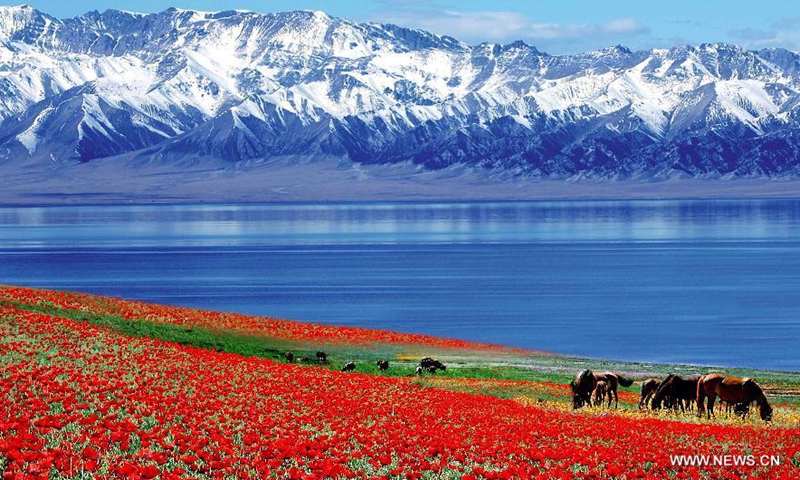
A view of Xinjiang File Photo: Xinhua
The famous China-Japan friendship figure Yasutaka Kojima, who has been closely connected with Xinjiang for half of his life, is 81 years old this year. Currently serving as an advisor to the Xinjiang Uygur Autonomous Region and honorary citizen of Urumqi, Kojima has visited Xinjiang over 150 times since 1982.
In a recent interview with the Global Times, Kojima said the Japanese media has biased views and many inaccuracies in their reports on China and its Xinjiang region. "Currently, China-Japan relations are relatively cold, but despite my old age, I am still willing to actively contribute to enhancing people-to-people exchanges between Japan and China."
After the pandemic, in September, Kojima visited the Xinjiang region again, and during his 22-day stay in the region, he went to many cities, including Urumqi, Korla, Ruoqiang, Hotan, Kashi, Aksu, and Hami.
Kojima mentioned that during dinner, people used the symbolic Xinjiang beverage pomegranate juice for toasting and he also saw many cultural and creative products featuring a Han Dynasty (206BC-AD220) brocade armband embroidered with the words "Five stars rise in the east, benefiting China," which was unearthed in Hotan. All these experiences allowed him to gain a deeper understanding of Xinjiang's stability and development.
Kojima first set foot on Xinjiang soil in June 1982. Although he didn't find the gemstones that he had heard about prior to his visit, he formed an inseparable bond with the region.
Kojima recalled to Global Times that during his trip from Urumqi to Turpan, he unexpectedly encountered heavy rain on the return journey, and the road was blocked. At that time, there were only two flights per week from Urumqi to Beijing, and missing it would have affected the rest of his itinerary.
His Xinjiang friends found a way to help him catch a night freight train, allowing him to return to Urumqi as scheduled. The region's rich cultural heritage and the warmth of its people touched Kojima, and since then, he has made multiple trips to Xinjiang.
In May 1986, while visiting the Kizil Cave-Temple Complex in Baicheng, Aksu Prefecture, Kojima was moved by the local people's efforts to protect the murals, and donated 100,000 yuan to the cause. Kojima is the first foreigner to donate to the protection of cultural relics in the region.
The Kizil Caves site is associated with the ancient Buddhist kingdom of Kucha [Qiuci in Chinese], located in the ancient Silk Road. The kingdom lies in present-day Baicheng county of Aksu Prefecture.
There are 339 caves at the site with a total of 4,000 square meters of wall paintings and some colorful clay sculptures within them. All these caves were carved into the cliff of a mountain extending 2 kilometers from east to west.
In June 2014, the Chang'an-Tianshan corridor was successfully inscribed on the World Heritage List, and the Kizil Caves became a part of it. Upon hearing the news, Kojima and his wife cheered and immediately called their friends in Xinjiang to congratulate them, saying "this is the result of the Chinese government's active efforts."
During the restoration process of the Kizil Caves, Kojima learned that there was another site in the Taklamakan Desert, the Niya Ruins, that had not undergone formal exploration. At his suggestion, China and Japan began joint exploration of the Niya Ruins in 1988. Seven years later, the "Five stars rise in the east, benefiting China" brocade was discovered there.
Kojima told Global Times that this year marks the 10th anniversary of China's proposal to jointly build the "Belt and Road Initiative" and the Niya Ruins are the remains of the "Jingjue Kingdom," one of the 36 Western Regions recorded in the Book of Han, witnessing the close connection between the Western Regions and the Central Plains along the ancient Silk Road.
In addition to archaeology, Kojima has also been committed to supporting education in the Xinjiang region. Since 1986, he has established scholarships in the region, providing annual funding of 1 to 2 million yen to support 150 Xinjiang students, which was equivalent to half a year's living expenses at that time.
Once, when he was taking a taxi in Urumqi, the driver asked him, "Are you Mr. Kojima?" After getting confirmation that he was indeed Kojima, the driver refused to accept the fare and said that his sister received a lot of help from Kojima's scholarship. Kojima could only express his gratitude by signing his name on a business card.
During the pandemic, Kojima browsed Chinese media outlets daily to stay informed of the situation in Xinjiang. He also used the internet, publications, and speeches to clarify false reports about China's Xinjiang region in Japanese society.
Kojima also participated in activities such as "Xinjiang is a Good Place" jointly organized by the Xinjiang Culture and Tourism Department and the Chinese Consulate General in Osaka, allowing more people to understand the real Xinjiang and encouraging them to visit Xinjiang personally if they have the opportunity.
During this trip to the Xinjiang region, Kojima took a week-long journey on the world's first desert railway loop, the Taklamakan Desert railway loop, which made him extremely happy.
He said emotionally to the Global Times, "Some people only attend part of the journey, but it's rare to take the whole week. Xinjiang is my second hometown, and I have devoted half of my life's passion to its development. After I pass away, please bury my remains in the Taklamakan Desert."




